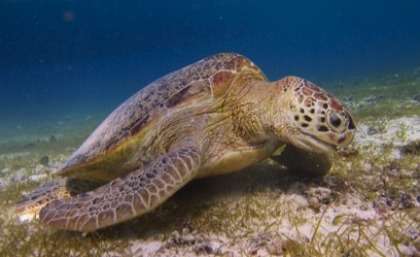Rethink needed on turtle conservation

(Phys.org) —Green turtle populations have expanded so much in Indonesia's east coast islands marine protected areas that they are adopting new feeding habits, degrading the ecosystem and threatening their own conservation.
Scientists and conservationists had believed that marine protected areas would be key to enhancing the recovery of protected species and ecosystems.
But a new international study by The University of Queensland and Radboud University Nijmegen in the Netherlands has shown this conservation method may have the opposite effect.
Lead scientist Dr Marjolijn Christianen from Radboud University Nijmegen in the Netherlands and her collaborators, including Professor Peter Mumby from The University of Queensland, have shown that destructive grazing of high numbers of green turtles concentrated in a small number of marine protected areas leads to on-going degradation and imminent collapse of seagrass habitat.
The study found that when the turtle numbers increased to about 20 turtles per hectare their foraging habits changed from eating only seagrass tips to digging up and consuming the roots and rhizomes, creating abundant bare gaps and increasing erosion and reducing seagrass regrowth.
Dr Christiansen said the study used a combination of experiments, monitoring and computer models to determine that the increasing grazer density of the turtles would cause a sudden collapse of their own habitat.
"We discovered that turtles adopted a new grazing strategy and started to dig for roots after they had already removed 100 per cent of the plants that lie above the seabed," Dr Christianen said.
"This is primarily because turtles from the area concentrated inside the reserve and reached unprecedented population densities."
UQ's Professor Mumby said recent protection efforts had been successful in many areas worldwide, but green turtles still remained highly threatened.
"The protection of major nesting beaches, tightened hunting restrictions, and additional conservation measures have led to population increase, including inside marine protected areas," Professor Mumby said.
"At the same time, however, their feeding grounds – sea grass meadows – have been declining worldwide at a fast rate as a result of poor management of coastal pollution.
"As a result, seagrass beds – the turtle's favoured habitat – have declined."
He said it was alarming to see turtles using such desperate strategies to find food and that the real conservation problem was not the marine protected areas but the lack of good seagrass habitat in unprotected areas.
"We really need to do more to protect coastal areas and the quality of their habitats, and this means controlling development and agricultural chemicals, and preventing mud entering rivers," he said.
Provided by University of Queensland



















